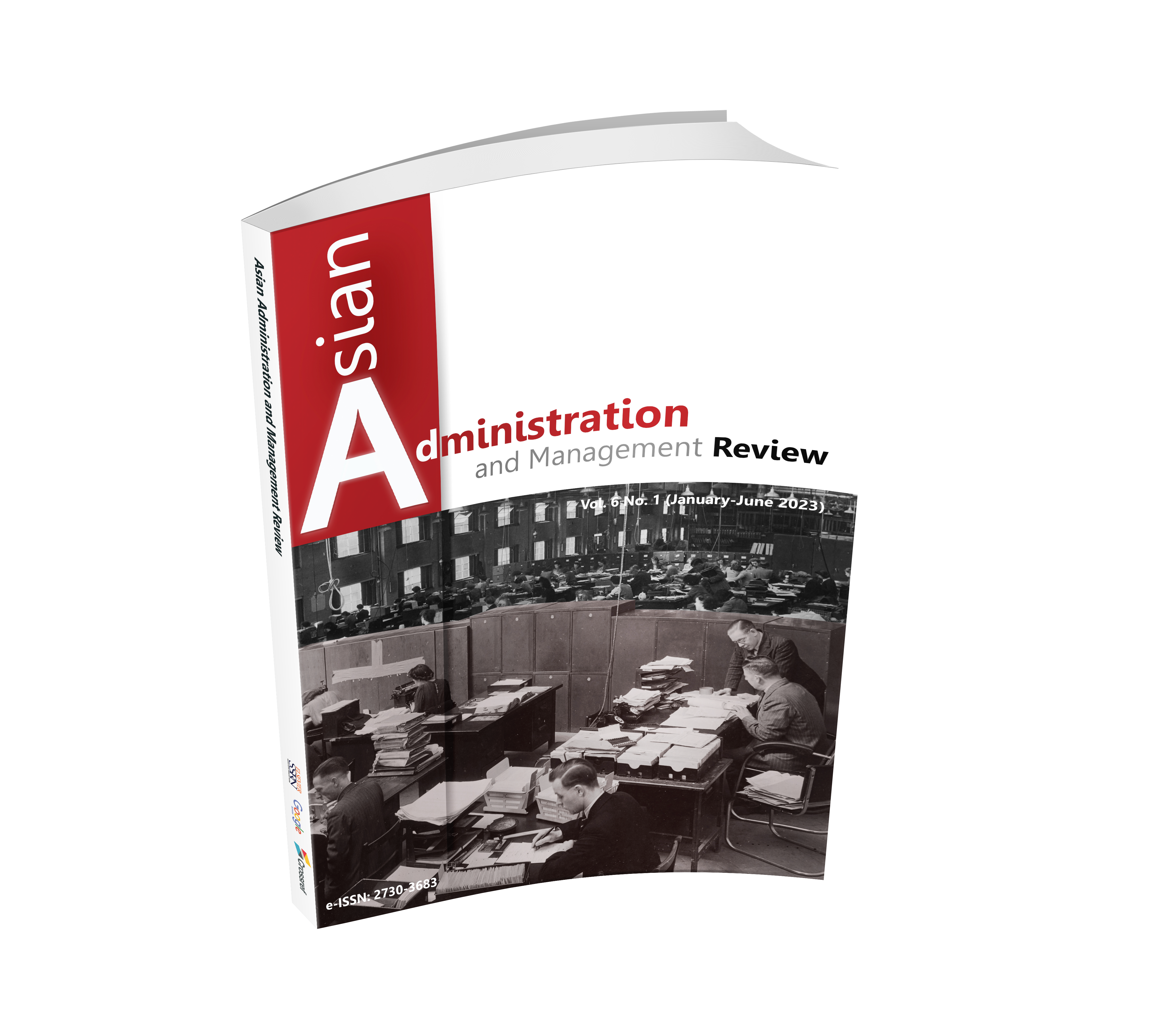THE ANTECEDENTS AND SUCCESS OF THE THAI SPA BUSINESS
DOI:
https://doi.org/10.14456/aamr.2023.4Keywords:
Antecedents, Success of Spa Business, Thailand, Service Quality, 7Ps StrategyAbstract
The objectives of this mixed method research combined both quantitative and qualitative methods were 1) to investigate the degree of predominance including service quality, 7Ps strategy, and administration critical to the success of the spa business in Thailand, 2) to study the impact of service quality, the 7Ps strategy, and administration on the performance of the Thai spa company, 3) to develop a model for the Thailand spa business’s success. The sample group consisted of 400 spa business entrepreneurs in Thailand researched with stratified random sampling and simple random sampling. The key informants were 18 spa business entrepreneurs in Thailand by purposive random sampling. The tool used in the data collection is a semi-structured interview. The quantitative data were analyzed by a structural equation model using the LISREL program and the content analysis was used in the qualitative data. The research results revealed that 1) service quality, 7Ps strategy, and administration is at the highest level, respectively, while the success of the spa business in Thailand is at a high level with an average of 4.19. 2) The service quality, the 7 Ps strategy, and administration all have a statistically significant impact on spa business success at the.05 levels. 3) The development of a spa business success model in Thailand is MQ2S Model. The qualitative research results promoted the importance of spa business management. The findings of this research can be used as the approach in formulating the policy in spa business operation to encourage entrepreneurs to operate a spa company in Thailand and be successful in long-term competition.
Downloads
References
Ahmed, A., McGough, D., & Mateo-Garcia, M. (2017). Testing Innovative Technologies for Energy-Efficiency: Coventry University as a Living Lab. The International Journal Entrepreneurship and Sustainability Issues, 4(3), 257-270.
Alahmed, M. (2018). Identifying the Determents of Government E-Service Quality in the UAE. Doctor of Business Administration Thesis, United Arab Emirates University.
Alan, B., & Robert, G. (1995). Analyzing Qualitative Data. London: Routledge.
Butler, R., & Szromek, A. (2019). Incorporating the Value Proposition for Society with Business Models of Health Tourism Enterprises. Sustainability, 11(23), 6711.
Cadena, Z. (2019). The Profile of the Businessman and Its Relationship with the Factors of Business Success in the MSME of the Services Sector. Revista de Administração Unimep, 17(4), 111-126.
Chantra, S., & Ngamsirijit, W. (2020). The Study of Key Success Factors of Wellness Tourism Service Business: Case of Spa Business. Journal of Thai Hospitality & Tourism, 15(1), 58-71.
Charak, N. (2019). Role of spa resorts in promoting India as a preferred wellness tourism destination - a case of Himalayas. International Journal of Spa and Wellness, 2(1), 53-62.
Chowdhury, M. (2017). How to Use 7Ps Marketing in Wellness Business. Retrieved from https://opportunityindia.franchiseindia.com/article/how-to-use-7ps-marketing-in-well
ness-business-9355.
Clarke, A., Azara, I., & Michopoulou, E. (2018). The Vision and the Mission of the International Journal of Spa and Wellness. Internal Journal of Spa and Wellness, 1(1), 1-3.
Craig, V. (2018). The Impacts of High-Volume Massage on Spa Therapists’ Physical and Mental Wellness. International Journal of Spa and Wellness, 1(3), 218-227.
Da Silva, M., Costa, R., & Moreira, A. (2018). The influence of travel agents and tour operators' perspectives on a tourism destination. The case of Portuguese intermediaries on Brazil's image. Journal of Hospitality and Tourism Management, 34, 93-104.
Department of Business Development. (2018). Handbook of Quality Standards for Spa Business Management. Retrieved from www.dbd.go.th/more_news.php?cid=1155.
Department of Health Service Support, Ministry of Public Health. (2020). Number of Spa Business operators registered as health establishments in Thailand in 2020. Retrieved from https://hss.moph.go.th/HssDepartment/file_reference/20210430829887180.pdf.
Global Wellness Institute. (2020). Wellness Tourism Initiative 2020 Global Survey Results. Retrieved from https://globalwellnessinstitute.org/wp-content/uploads/2020/05/GWI_FACT_SHEET_BUSINESS_TRAVEL2020.pdf.
Globaldata. (2020). Health and Wellness Tourism Trips to Asia to Reach 128.3 Million by 2022. Retrieved from www.globaldata.com/media/coronavirus/health-and-wellness-tourism-trips-to-asia-to-reach-128-3-million-by-2022-says-globaldata/#:~:text=GlobalData%20forecasts%20health%20and%20wellness,CAGR%20of%205.6%%20from%202019.
Gowan, D. (2017). Exploring Patient Safety Issues in Massage Therapy and Understanding Patient Safety Incidents (Adverse Events). Doctor of Philosophy Thesis, University of Saskatchewan.
Guillet, B., & Kucukusta, D. (2019). Analyzing Attributes of the Spa Service Experience: Perceptions of Spa-Goers Traveling to Hong Kong. Journal of China Tourism Research, 15(1), 66-83.
Gyimóthy, S. (2018). The Attractiveness of Spa Destinations. Retrieved from https://projekter.aau.dk/projekter/files/280519738/thesis.pdf.
Han, H., Kiatkawsin, K., Jung, H., & Kim, W. (2018). The Role of Wellness Spa Tourism Performance in Building Destination Loyalty: The Case of Thailand. Journal of Travel & Tourism Marketing, 35(5), 595-610.
Huang, Y., Chen, C., & Gao, M. (2019). Customer Experience, Well-Being, and Loyalty in the Spa Hotel Context: Integrating the Top-Down & Bottom-Up Theories of Well-Being. Journal of Travel & Tourism Marketing, 36(5), 595-611.
Huh, C., Lee, M., & Lee, S. (2019). A profile of spa-goers in the U.S. luxury hotels and resorts: a posteriori market segmentation approach. Journal of Hospitality Marketing & Management, 28(8), 1032-1052.
International Spa Academy. (n.d.). Premier Spa Institute in India. Retrieved From https://ispaa.com/about-us.
Jumanazarov, S., Kamilov, A., & Kiatkawsin, K. (2020). Impact of Samarkand’s Destination Attributes on International Tourists’ Revisit and Word-of-Mouth Intention. Sustainability, 12(12), 5154.
Kasagranda, A., & Gurnák, D. (2017). Spa and Wellness Tourism in Slovakia (A Geographical Analysis). Czech Journal of Tourism, 6(1), 27-53.
Koskinen, V., & Wilska, T. (2019). Identifying and Understanding Spa Tourists’ Wellness Attitudes. Scandinavian Journal of Hospitality and Tourism, 19(3), 259-277.
Kotler, P., & Keller, K. (2016). Marketing Management. 15th ed. Edinburgh: Pearson Education.
Lam, L., & Gao, Y. (2020). Hong Kong Millennials’ Intention to Visit Local Hotel Spas. Journal of China Tourism Research, 16(4), 510-526.
Lee, D. (2020). The Impact of Exhibition Service Quality on General Attendees’ Satisfaction through Distinct Mediating Roles of Perceived Value. Asia Pacific Journal of Marketing and Logistics, 32(3), 793-816.
Lee, P., Lee, M., & Cheng, T. (2019). Importance of Wellness Concepts in the Hotel Industry: Perspectives from the Millennials. Journal of Quality Assurance in Hospitality & Tourism, 20(6), 729-752.
Lin, I., & Mattila, A. (2018). A Conceptual Model of Co-Creating an Authentic Luxury Spa Experience. International Journal of Spa and Wellness, 1(1), 39-54.
Oh, H., & Kim, K. (2017). Customer Satisfaction, Service Quality, and Customer Value: Years 2000-2015. International Journal of Contemporary Hospitality Management, 29(1), 2-29.
Pandey, B., Ritthichairoek, A., & Puntien, S. (2020). Examination of Marketing Mix Factors in Chinese Tourists’ Demand for Spa Service in Middle-Sized Bangkok Hotels. A paper presented at the 11th International Academic Conference, Suan Sunandha Rajabhat University, Thailand.
Panfiluk, E., & Szymanska, E. (2017). The Measurement of the Innovativeness of Health Tourism Services using an Adequacy Matrix Title of the Article. Entrepreneurship and Sustainability Issues, 4(4), 400-420.
Parasuraman, A., Zeithaml, V., & Berry, L. (1988). SERVQUAL: A Multiple-Item Scale for Measuring Consumer Perceptions of Service Quality. Journal of Retailing, 64(1), 12-40.
Pothisita, C. (2021). Science and Art of Qualitative Research. 9th ed. Bangkok: Chulalongkorn University Press.
Rodrigues, H. (2017). A Scoping Review: Exploring the World of Medical and Wellness Tourism. Doctor of Management Thesis, University Institute of Lisbon.
Schmidt, S. (2021). The Growth of the Global Spa Industry. Retrieved from https://blog.marketresearch.com/the-growth-of-the-global-spa-industry.
Schumacker, R., & Lomax, R. (2016). A beginner’s guide to structural equation modeling. 4th ed. New York: Taylor & Francis.
Sevilmiş, A., Erdoğan, A., & Şirin, E. (2019). Content Analysis of the Theses Done on Service Quality in Sports (2005-2017). The Journal of Eurasia Sports Sciences & Medicine, 1(1), 31-45.
Smith, M., & Wallace, M. (2019). An analysis of key issues in spa management: viewpoints from international industry professionals. International Journal of Spa and Wellness, 2(3), 119-134.
Srinita (2018). The Effect of Service Quality and Marketing Mix Strategy towards Local Sustainable Economic Growth. European Research Studies Journal, 21(1), 272-284.
Strack, F. (2018). Consuming or overconsuming? Sustainability in Hungarian medical hotels. International Journal of Spa and Wellness, 1(1), 20-38.
Szymanska, E., & Lech, J. (2017). Modern Tendencies in Spa Tourism: Innovations. A paper presented at the 24th International Scientific Conference on Economic and Social Development, Warsaw, Poland.
Thornsiripunnarote, T., Tunpow, K., & Kanchanathaveekul, K. (2019). Marketing Strategy to Success of Spa Enterpreneur Through Digital Channel in Bangkok Digital Channel in Metropolitan Region. Journal of the Association of Researchers, 24(1), 72-84.
Timberlake, J. (2020). Spa and Wellness Trends For 2020. Retrieved from https://eminenceorganics.com/us/blog/2020/01/20/spa-and-wellness-trends-2020.
UKEssays. (2018a). Spa and Wellness Trends in Tourism. Retrieved from www.ukessays.com/essays/tourism/the-impact-of-the-spa.php?vref=1.
UKEssays. (2018b). The Trend of The Wellness Industry. Retrieved from www.ukessays.com/essays/tourism/the-trend-of-the-wellness-industry-tourism-essay.php?vref=1.
Valeriani, F., Margarucci, L., & Spica, V. (2018). Recreational Use of Spa Thermal Waters: Criticisms and Perspectives for Innovative Treatments. International Journal of Environmental Research and Public Health, 15(12), 2675.
Whitley, A. (2022). Signature Stone Crop Body Treatment for Spa Professionals. Retrieved from https://eminenceorganics.com/ca/blog/2019/06/17/signature-stone-crop-body-treatment-spa-professionals.
Yasa, P., Sitiari, N., & Kreswanto, I. (2020). The Effect of Entrepreneurship Orientation and Organizational Culture on Funding Decisions and Organizational Performance on Spa Product Smes in Bali Province. Journal of Talent Development and Excellence, 12(1), 3426-3447.

Downloads
Published
How to Cite
Issue
Section
License
Copyright (c) 2023 Authors

This work is licensed under a Creative Commons Attribution-NonCommercial-NoDerivatives 4.0 International License.











.png)


